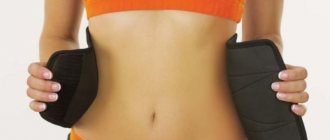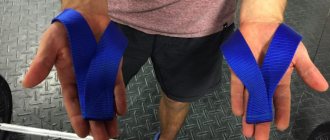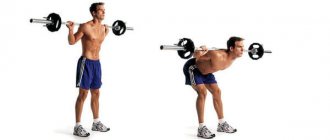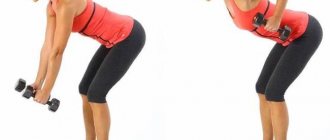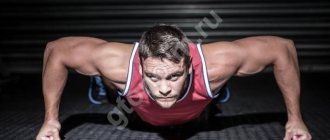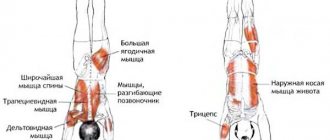December 10, 2020 Admin Home page » Training details
The question is revealed - how to properly use an athletic belt in the gym, when to wear it and when not to. The consequences of its use, how to buy it correctly and other important tips and recommendations.
What is it needed for
Athletically, the belt is used in weightlifting, powerlifting, and bodybuilding as part of the equipment. It helps the athlete lift heavy weights while maintaining a healthy back.
An athletic belt is needed for those who:
- The belt is mandatory for those people who have some health problems. These are various back injuries. For training in this condition, a belt is a must. It reduces the load on the spine, while acting as a corset.
- The belt is suitable for those who are going to break their own records during training or competition. Muscles may not always be ready for such loads, which increases the risk of injury.
- If you wear an athletic belt for a long time and want to train without it, you should not suddenly abandon this equipment. The muscles will simply not be ready for such loads, because they are used to being supported by a belt. Therefore, you should give up the belt gradually. During your warm-up, perform sets with light weights without wearing a belt. And remember - training your back muscles will take much less time than restoring it after injury.
Weightlifting belt: to use or not?
Depending on who you ask, “Should I use a weightlifting belt?”, you may get a resounding “yes,” a dismissive “no,” or a disinterested “whatever.” For example, powerlifters are obsessed with specialized belts, while CrossFitters pride themselves on never using a belt. Bodybuilders are divided into those who believe in the importance of the belt for safety and performance, and those who believe that in the long term the belt increases the risk of injury. Weightlifters don't worry too much about this.
Taking all this into account, it can be difficult to answer a simple question. Let's discuss all the pros and cons.
Brief overview
For the belt:
- Possibly helps prevent lower back injuries when lifting heavy weights.
- May increase exercise performance.
Against the belt:
- Possibly impairs motor learning of abdominal muscles.
- The lower back may not receive enough load.
Do I need to wear a weightlifting belt? Arguments for"
The basis for wearing a belt is the idea of intra-abdominal pressure. A study by Miyamoto, et al. found that "...using a maximal isometric effort straining belt during weight lifting significantly increases spinal extensor support via intra-abdominal pressure." In short, if you increase the pressure in your abdomen, you will better stabilize the entire region, which will create a safer environment for your spine and may increase your ability to lift weights.
In another experiment, Kingma et al. showed that “... when lifting a weight while inhaling, a dense, rigid back belt reduces the load on the spine. This is due to the torque created by the belt, not intra-abdominal pressure,” an additional reason to wear a belt.
Let's look at the three types of belts that are most widely used and the possible benefits of each.
- Powerlifting belt
Powerlifters wear belts like the InzerForeverBelt because it allows them to squat and lift more weight.
Possible safety benefits are secondary. Belts designed for powerlifting competitions are durable, rigid and uniform in circumference. In fact, the large area of the abdomen in contact with the belt, combined with a buckle that allows you to tighten the belt as tight as you want without impeding movement, allows you to create significant internal pressure.
More pressure means more stability and more weight. It's really very simple.
- Velcro belts
Velcro belts like the Harbinger have a different purpose. They are usually made from synthetic materials. Since the Velcro depends on how firmly it stays on your body, there is a limit to how much pressure you can apply before your belt will “float” and become loose. Much less intra-abdominal pressure is generated. You may have some protection from injury, but you won't get a significant increase in exercise performance.
Bodybuilding belts are hybrids in terms of what you get out of them.
Do I need to wear a weightlifting belt? Arguments against"
There are two main arguments against using a belt.
- The belt interferes with learning movements.
The first doubts relate to the possibility of interfering with movement learning. Many of the best gym exercises require proper recruitment of the abdominal muscles (including the obliques and transverse muscles). When lifting significant weights, a weightlifting belt prevents beginners from contracting their abdominal muscles sufficiently in the desired direction. The belt simply takes over these functions.
The issue is easily resolved if you have a good coach or pay attention to it. You should not use a belt when training your core muscles, stabilization, and technique. But it should be obvious.
- The belt will make your lower back weak.
The second problem is that wearing a belt will make your lower back weaker than it would be without it. Why? Because the belt removes the load from the back, which would lead to the necessary adaptation.
Let's think a little. All the strongest powerlifters on the planet wear a belt during training and competitions. Do you really think they have a weak lower back due to constant use of the belt? Wearing a belt may reduce some of the stress on your lower back, but this difference is more than made up for by the extra weight you lift through increased internal pressure or simply the psychological support you receive when you feel safer.
The correlation between those who use the belt and those who are extremely strong is very high.
Conclusions:
So what do I recommend?
I'm one of those people who "don't care." If you decide to use a belt, choose a simple Velcro belt. Avoid hard leather options. It looks cooler, but I'm against using belts to improve performance unless you're a competitive powerlifter.
A Velcro belt will give you an increase in results, but it will be relatively small. The basis for deciding to wear a belt or not is the belief that it will give you stability and reduce the likelihood of injury. Therefore, I recommend using only a Velcro belt.
Some people I know wear weightlifting belts, others never do. Some people wear a belt on every set, even during warm-ups! Others leave it alone except for the heaviest sets of clean and jerks, squats and deadlifts. From my own experience, I can say that I never experience pain when I wear a belt. But if I don’t put it on, I feel pain later. You could argue that if I don't wear a belt for a long time, I'll adapt. But take into account that I trained very seriously without a belt for over ten years. I've tried both options for some time and prefer to wear a belt.
The decision to wear a belt is a very personal one, but it should not be taken too seriously. If you feel more confident in a belt, wear it! If you feel awkward and uncomfortable, don't wear it. The main thing that matters is never let anyone decide for you.
Translation by FPA expert S. Strukov.
Posted by Nick Horton
In what cases is it not needed?
When an athlete wears a belt, intra-abdominal pressure increases. Thanks to this, the spine and intervertebral discs are fixed in one position. Your abdominal muscles tighten during the approach, and you press your stomach into your waistband—this helps keep your spine straight.
Your lower back stabilizing muscles become weaker. Regular wearing of an athletic belt during training leads to this.
Moreover, if you decide to take the weight without a belt a little less than usual, then there is a high probability of getting a back injury. When training without a belt, the abdominal muscles must be contracted and pulled towards the back, and not protruded as when training with a belt. It is necessary to combine training with large weights with a belt and small ones without a belt.
If you exercise for your own pleasure and the beauty of your body, then a belt can bring you a lot of trouble. Attention should be paid to strengthening the abdominal and back muscles. The weight of the bar should increase gradually. Gain muscle growth.
How to wear it correctly?
How to use a weightlifting belt? It’s worth noting right away that you definitely shouldn’t put it on constantly and wear it throughout the entire workout; this will negatively affect muscle function. Firstly, they will stop working normally and, with constant wearing of the belt, can gradually atrophy.
In this case, if you suddenly abandon the belt, you will certainly get a spinal injury. Secondly, the muscles work differently in the waist. If without it they contract to pull in the stomach, then in the belt you, on the contrary, will tend to stick out the stomach. As a result, after abandoning the device, you will not be able to perform exercises with weights correctly.
A few rules for using a belt:
- Wear the belt before performing exercises that involve holding weights overhead or those that involve standing with weights.
- After the exercise, be sure to remove the belt.
- When using such a device, pay special attention to additional training of the abdominal muscles.
- You should not perform more than 5-10 repetitions in the belt. You can perform one set of the belt with the maximum weight, then remove it and reduce the weight.
- Once you can lift heavy weights and get used to it, begin to gradually abandon the belt, reducing the number of repetitions performed in it.
Kinds
Belt for bodybuilding and weightlifting
The wide part of such a belt is adjacent to the back, the narrow part is fastened in front. Thanks to the different levels of the belt, your back will be supported and your torso will be able to bend forward.
Powerlifting belt
This belt is the same size across the entire width. And it is approximately 10 cm wide. It is ideal for exercises in which you should keep your back straight. This belt is heavier and thicker and also more expensive. The wide part of the belt will not allow you to bend forward and will help maintain the abdominal wall and internal pressure. The following exercises are typical for this belt: squats, deadlifts.
During training, you often have to perform various exercises, so it is advisable to have both belts. They will help you perform each exercise efficiently and without harm to your health.
What are the types
There are two types of belt:
- weightlifting - can be of different widths. The widest part is adjacent to the lower back. It is flexible and easy to use for bending exercises. Most suitable for bodybuilding.
- for powerlifting - the equipment has the same ten-centimeter width along its entire length. Placed on the area close to the pelvic bones. The product is strong, massive, and fits quite tightly. Has considerable thickness. Best suited for exercises that require a straight back.
Material
The cheapest option would be a belt made of synthetic material. Belts like these are fastened with Velcro. It is worth noting that the Velcro fastener is very reliable and can serve you for about a year. After a year, just change the Velcro. This belt is worth purchasing if you want to work with light to medium weights.
Belts with clasps can stretch and tear between teeth over time. If you notice signs that the holes are starting to tear, treat them with superglue to prevent the belt from completely tearing.
The middle price category includes leatherette belts. This type of belt is the most diverse both in fasteners and in prices.
The strongest and most durable belt is a belt made of genuine leather. It is also worth noting that this is the most expensive option. It is not suitable for people with problem skin. During exercise, you will sweat a lot, which can lead to additional skin irritation due to friction with the belt. In this situation, it is preferable to choose a soft belt made of synthetic materials.
The soft belt has a number of other advantages: it does not restrict movement and is practically invisible on the body. It can be found not only with Velcro, but also with plastic and iron fasteners. A very convenient option is a belt made of nylon material. It is elastic.
Lenght and width
The belt should be selected individually. The fitting will show everything. Pull the belt tightly and fasten it on the middle row of fixation holes.
The best fastener option would be a ratchet mechanism. It is reliable and will help you to adjust the belt to you as comfortably and accurately as possible.
Flexibility and durability
If the athletic belt consists of several layers of leather and is stitched with a zigzag seam, it will be the most durable and will be able to adapt well to the shape of the body.
A good belt should absorb moisture, be made of durable material and moderately elastic, and should also have special holes for ventilation.
The belts can be fixed manually or automatically. It is worth giving preference to the first option. Pay attention to the fixing element: it must be strong.
Traction straps. When your hands can no longer do it, but your head wants to 
Continuing the sports theme, let's talk about traction straps. The thing is highly specialized and extremely simple. As a rule, beginners do not need it, but sooner or later beginners cease to be so... What are athletic straps for? When performing exercises with large weights, the hands can no longer cope with the weight of the projectile and the fingers begin to unclench. This leads to a reduction in the number of approaches per exercise and limitation of working weights. Which exercises (at a minimum) may require straps:
1. Deadlift 2. Bent-over row 3. Pull-up on the horizontal bar with weights.
The presence of straps helps to transfer part of the load to the wrist, increase achievements in exercises, and therefore continue muscle growth.
What types of straps are there? For starters, they are made from different materials. As a rule, these are cotton, synthetics and leather. Cotton is softer, but it stretches over time, synthetic does not stretch, but it is stiffer, and leather is somewhere in the middle.
1. The most ordinary of the belt, not sewn at all
2. From a belt, sewn into a loop
3. Sewn into a ring, with soft padding and perpendicular fastening
4. With steel hook
What is the difference between them? In fact, there is not that much of it. We can probably say that it’s just that the straps are a little more difficult to wrap around the projectile at first.
But over time, this becomes a quick, familiar and inconvenient procedure. But since beginners try to purchase their first straps as simple as possible, from the point of view of convenience, they take other types of straps, and then stay with them.
Belts sewn into a loop are the most common, because... they are easy to make yourself and are comfortable if made from cotton. They are more convenient to use than just belts. Synthetic loop belts cut your hands and are therefore not as common. Winding them is even easier, but putting the loop on itself requires a little attention. The loop is worn differently on the right and left hands.
Belts with a steel hook do not require any winding, but they have one significant drawback that limits their use. The apparatus (barbell or dumbbell) cannot be released by opening your palm. This adds risk if something goes wrong during the exercise.
And finally, the heroes of the review: Belts with an adjustable ring strap, padded with soft fabric
They are fastened with Velcro, with a fairly solid metal ring.
There is a soft pad around the wrist. They cannot be put on incorrectly, and the fixation around the wrist is not done by tightening the loop, but can be limited to a comfortable level. I personally found this more convenient.
How to use belts? Yes, it’s very simple, and it’s better to see once than to hear or read a hundred times.
And as a resume. The straps are good, they helped me move to the next level in the deadlift))) It’s convenient to use, it’s comfortable for my wrists.
Good luck in sports, joy and health!
Purchase
The best manufacturing companies
Athletic belts are produced by many companies. Here is a list of the most famous: Adidas, Vamp, Grizzly, Mad Max, Torneo, Ironman, Jet Sport, Schiek. These companies produce belts for both professionals and amateurs. The quality of the belt is directly dependent on its price. It is worth understanding that when buying a cheap athletic belt, it may soon become unusable.
Prices
A good athletic belt won't come cheap. But if you are a beginner or don’t want to lift heavy weights, then you can look at budget options. A Torneo belt made of synthetic material will cost you about 700 rubles. A belt made of genuine Grizzly leather will cost 2000-2500 rubles. The cost of a professional athletic belt starts from 2500-3500 rubles.
What to remember when buying an athletic belt
- A belt made of genuine leather will cost much more than its artificial counterparts. Don't buy the cheapest belt. It may not last long. As a result, you will have to spend money on purchasing a new belt.
- If you do not have the opportunity to purchase a belt made of genuine leather, then a belt made of a combined material will do. It is made from natural and synthetic materials.
- Faux leather belts may attract you with their affordable price, but they don't last long.
Women's athletic belt
When choosing a women's athletic belt, you should follow the same principles as described earlier. It should fit you perfectly, not constrain you, and hold your back. Don't forget about all the pros and cons before you decide to use this type of equipment.
There are different belts. They differ in materials, fasteners, cost and type of training. The main thing is to choose a belt that suits you. It should fit you well: hold your back, be elastic, comfortable to wear. You need to take precautions if you want to exercise with or without a belt. Good luck with your training!

